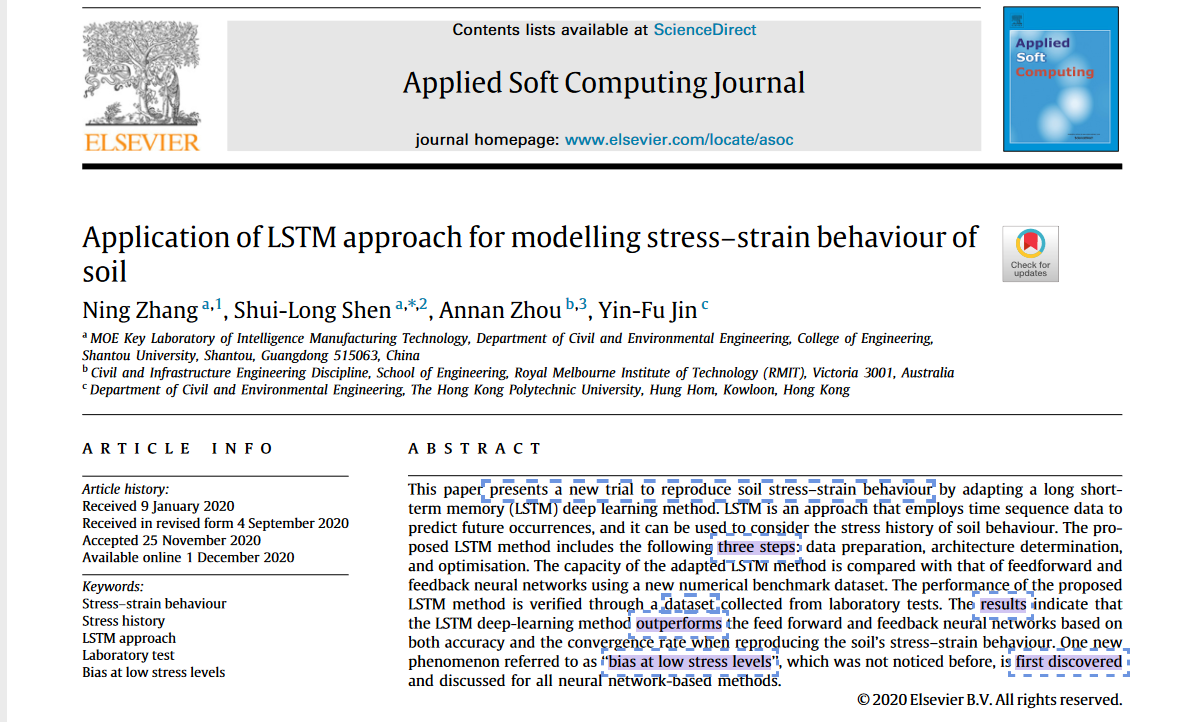Application of LSTM approach for modelling stress-strain behaviour of soil
- 岩土工程
- 2022-10-21
- 205热度
- 0评论
Q1:**文章提出的工程问题是什么?
有什么实际工程价值?**
Present a new trial to reproduce soil stress-strain behaviour
First discovered a new pehnomeon “bias at low stress levels” for nn methods
Q2:文章提出的学术问题是什么?
有什么新的学术贡献?
The capacity is outperforms the feed forward and feedback neural networks
To reduce the soil’s stress-strain behaviour
Q3:文章提出的技术路线是什么?
有什么改进创新之处?
three steps:
data preparation
architecture determination
optimistisation
Q4:文章是如何验证和解决问题的?
- Introduction stress-strain of behaviours soils show high nonlinearity soli behaviour model base on mechanical hypotheses(elasticity elastoplasticity hypoplasticity) one model only for a special soil and difficult to determine NN - FFNNs -FBNNs - NANNs -RNNs LSTM can learn both the long and short_term influences
- Methofology
- 2.1 LSTM deep-learning network
- 2.2.1 data preparation: component of input data , data be normalised 0-1
- 2.2.2 architecture determination: adptive determination method , empirical method
- 2.2.3 optimisation method: evolutionary algorithms gradient decent(low computer cost) :batch gradient (small datasets)/ stochastic gradient descent algorithms
- Experiments and results
numerical to verifying the improvement of LSTM in constrast to nn
laboratory dataset to comfirm the capacity os LSTM on real soil behaviours
- 3.1.1 numerical experiment Plaxis software; drained traixial ;100 training dataset 27testing dataset ;each 30-60steps up to 3000-6000 pairs
- 3.1.2 laboratory test sourced from Lee and Seed
- 3.2 modelling details three model : FFNN,FBNN,LSTM
- 3.3.1 numerical experiments LSTM outperform the feedback and feedforward models in convergence rate and precision. feedback model outperformed the feedforward model LSTM was more effective / overwhelm than the other two
- discussion
- 4.1 bias at low stress levels a high stess level corresponds to a higher soil strength the problem of bias at low stress levels should be examined in detail in future studies
- 4.2 complexity of models 229 weights of ff, 241 of fb, 985 of LSTM LSTM is worth the extra computer costs
- conclusions
- a new approach model the stress-strain behaviours by LSTM (Octave soft ware)
- LSTM outperformed in the precision and convergence rate
- LSTM had excellent performance on the measured stress-strain bahaviours
- bias at low stress is a common problem
Q5:文章有什么可取和不足之处?
计算机方面的Q1期刊
Q6:文章对自身的研究有什么启发?
启发很多:
- LSTM的结构组成
- 误差的箱型图 boxplots
- 雷达图的应用
- numerical 的来源,Plaxis进行大量的模拟


